What is it? Psoriasis is a disease of the skin of non -infectious nature, so it is impossible to infect. It not only affects the skin, but also has a negative effect on the whole body as a whole. It is characterized by a chronic course with periods of exacerbation and remissions.
The disease is caused by the immune cells of their own body, that is, it is an autoimmune disease. Rising from the depths of the skin to the upper layers, these cells cause inflammation, excessive separation of the cells of the epidermis, leading to excessive growth, the appearance of new small capillaries.
Externally, it seems that the formation of red or red spots - psoriatic plaques.
Because psoriasis is a systemic disease that affects all systems of the body - the patient suffers from general weakness, rapid fatigue.
The main symptom of the initial stage of psoriasis is psoriatic rashes and plaques, but he accompanies a person with the more incurring development of the disease.
They occur due to the accelerated uncontrolled division of cells located in the upper layer of keratinocytes. Included cells are formed and the skin in these areas thickens, acquires red due to the increased formation of new capillaries. This leads to slight drip bleeding for any, even slight plaques injury.
The surface of the plaques is often covered with a gray -shaped gray -like dusk. Even the term "paraffin lakes" is formed. This plaque consists of dead epithelium cells that accumulate on the surface of the plaques due to a disturbed rejection process.
Spots can reach quite large sizes, merge with each other. They are hot to the touch, often accompanied by severe itching. Combs can lead to infection.
Over time, the nails begin to change. Their surface becomes cut, pits appear, pink spots are noticeable under the nails - the accumulation of liquid, the nail turns yellow, thickens, takes the shape of bird nails. All this happens due to impaired nail and blood nutrition.
The nail bed is subjected to excessive deterioration, which leads to the rejection of the nail and the loss. Often there is a red inflamed border around the nails.
The small joints are affected by diseases and small joints - this is accompanied by pain and inflammation.
In addition to plaques, with psoriasis, papules are formed on the skin - small (about 1 mm) protruding formation that resemble a rash. Often localized to elbows and knees, preserved even during the remission period.
During the improvement, the plaques begin to shine from the middle, take the shape of the rings and can completely disappear. The pigmented areas remain in their place.
Psoriasis on the scalp has the same symptoms as on the body. In this case, the hair structure does not change. The rash also covers the adjacent areas of the skin - behind the ears, around the neck.
Types of psoriasis According to the symptoms, the disease is divided into two types: pustular and not pustular. There are several varieties of the disease in these groups.
Forms of pustular psoriasis:
summarized; mostly infrequent limbs; Ladomary; Impetigo. Not a pustular psoriasis:
ordinary (chronic psoriasis); Erythro-dodmo. In addition, the following types of disease are distinguished:
psoriasis of skin folds and flexion surfaces; medicine. Forms by gravity:
light (affected by less than 3 % of the body surface); average (affected up to 10 % of the body surface); Heavy (more than 10 % of the surfaces are affected). Depending on the shape of the rash, such types of psoriasis are distinguished:
point; Hagard; Money. Stages of psoriasis development, symptoms The first plaques appear in areas with dry skin and never happen where the skin is too wet, for example, armpits. First, the appearance of spots can be seen on the inside of the elbows, below the knees, along the border of the hair of the head, and in places subjected to any injury or rubbing. The location is usually symmetrical.
Take such stages during the disease:
progressive (formation of new spots, growth of existing, itching, noticeable peeling); Stationary (slowing or stopping the growth of plaques, lack of newly formed spots); Regression (reduction or lack of peeling, disappearance of spots and plaques with the appearance of pigmented areas of the skin in their place, signs of psoriasis are almost absent). There are no special tests to make a diagnosis. The diagnosis is made on the basis of external characteristics. One of these signs will be the appearance of bleeding when the plaques contact, the so -called bloody dew.
Another specific sign of psoriasis will be the presence of a pale border around a young papule, which is not yet covered with flakes. This seems to be the vascular reaction of the skin, which means the progression of the disease.
In severe forms of the disease, a blood count can change. There are signs of the flowing inflammatory process. In some cases, you need to have a biopsy to exclude other skin diseases and confirm the presence of psoriasis.
Effective Psoriasis Treatment In the treatment of psoriasis, both topical medicines and internal, physiotherapy and spa are used.
In the initial mild course of the disease, medicines in the form of ointments are used. First use ointments and creams with simple composition, then go to ointments containing hormones. Psoriasis cream should only be applied to plaques and spots.
Psoriasis Ointment: Review of Hormonal and Non -Hormonal Agents
The middle and severe course of the disease uses internal products that affect the whole body but produce the best results. This group includes vitamin A, immunosuppressants, cytostatics.
Physiotherapists carry a tangible relief for patients with psoriasis, can inhibit the development of the disease and sometimes replace the use of some medicines.
UV irradiation (phototherapy), laser, ultrasound and magnetotherapy, hyperthermia, electrons, electrophoresis, electrophoresis are used.
Psoriasis is able to gain resistance to the treatment used over time, therefore it is recommended to change the methods (treatment of treatment) from time to time.
Psoriasis Nutrition should help regulate metabolism and prevent or exacerbate skin symptoms. As almost all patients have a violation of lipid metabolism, preference should be given to low fat products.
The special diets of fire and others have acquired broad glory.
When you compile a diet, you should try to follow some simple rules:
Rejection of alcoholic beverages; Food up to 6 times a day, little by little; Exclude fried, smoked diet food; Reducing the content of salt in food; If possible, do not use products with the content of dyes, stabilizers and other nutritional supplements; Exclude citrus fruits; Increase the share of vegetables and cereals in the diet; Mandatory use of vegetable oils. Compliance with these simple rules will help to avoid exacerbation of psoriasis and independently compiling a therapeutic diet.

























